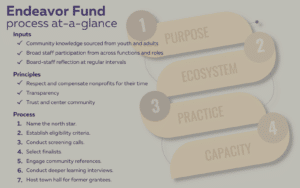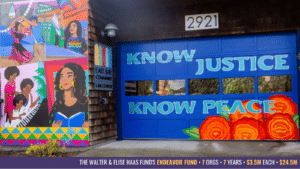Endeavor Fund as case study, part one
At the Walter & Elise Haas Fund, we’re making shifts in our practice and, at 71 years old, learning new things.
This blog shares our recent process for establishing the Endeavor Fund, a new $24.5M, seven-year initiative aimed at closing the racial and gender wealth gap that we designed with trust-based practices in mind. We’re offering it here for two reasons:
- to share our process in the hopes that you — our peers, our ecosystem, and community — can use it as a case study, perhaps like open-source trust-based philanthropy for you to build and improve upon and;
- to get better at using our learning muscle by openly showing, sharing, and reflecting on our work.

The changes our world needs are urgent, important, and often, massive. We neither have the time nor individual knowledge to work slowly towards creating perfect solutions. To quote our friends at the Stupski Foundation, “change can’t wait.” Thus, W&EHF aims now to be in a state of constant public learning. We’re of the mindset that mistakes, just as much as successes, are opportunities for progress as long we are moving forward, thoughtfully, and in community.
In other words, this blog is the first of what will become many opportunities to share practice and process, to reflect on lessons learned, and above all, to invite you, our peers in philanthropy, into the work with us.
This blog is an invitation to join a philanthropy learning lab. We want to hear from you. What questions or sparks of new ideas come to mind as you read this blog? What have we missed? What would you add? What have you already done in your own practices? How might we, and all of us, do better?
Endeavor Fund: What We Did
The Endeavor Fund process was focused on deep learning and operationalizing trust-based philanthropy. It was shaped by a decision-making rubric broken into five categories: purpose, practice, ecosystem, financial diligence, and commitment to learning. W&EHF focused on organizations that we were in current grantmaking relationships with, recognizing that we would be exiting 75% of grantees from the former programs of Economic Security, Education, and Safety Net. We listened carefully to how young people from our Learning Labs and BAY Fellows program directed us to act. From there, eligibility for the Endeavor Fund was determined by organizations’:
- Mission alignment to closing the racial and gender wealth gap
- Active prioritization of quality, empowering jobs within their organization
- Geography — hyper local to Oakland and/or San Francisco
- Service to primarily BIPOC communities
- Service to/with youth and adults
- Practice that is a combination of direct services and structural change work
- Majority BIPOC leadership among at least two of the following three: the executive, senior staff, and board
- Budget size (organizations with budgets under $5M and no more than $10M)
These factors affected individual selection as well as group composition.
Thirteen organizations were invited for an eligibility screening, a 30-minute call conducted by video; ten were invited for deeper learning interviews, three-hour long in-person interviews with teams from the organization and W&EHF staff. Organizations were represented by their leadership, a staff person, and a board member; W&EHF was represented by three or four of our ten-person staff. W&EHF staff transcribed the interviews in lieu of a written application from the organizations. Organizations were asked to submit written consent, to continue in the process. We told organizations that “consent” could simply be one word; most statements were a few sentences. W&EHF staff performed a financial analysis for each organization from public documents, which was shared in the interview to check our understanding. Seventy percent of W&EHF staff were actively engaged in the deeper learning process with the potential cohort.
Two references — a participant and a collaborator — gave testimony for each organization. What references said about the organizations was prioritized in the review and decision-making process.
Each reference was compensated for their time; each organization received a $3,000 grant for participating in the deeper learning interview; three organizations received unrestricted operating grants of $25,000 at the end of the process; and the seven organizations selected for the Endeavor Fund received seven-year long general operating grants for a total of $3.5 million, paid out annually in $500,000 installments.

All along the way, for 18 months, staff shared our thinking with W&EHF’s board so we were all part of the process of developing ideas, asking questions, and acting together.
A month after the public announcement of the Endeavor Fund grantees, we hosted a town hall for all former grantees of the closed programs. We plan to share a future blog in this series on operationalizing trust on how we exited grantees.
A Philanthropy Learning Lab
We continue the case study of the Endeavor Fund in part two in which we reflect on what we were trying to do, and the mistakes we know we made.
For now, with this case study as the first part of a philanthropy learning lab and blog series on how a foundation might operationalize trust-based practices, we’d like to start hearing from you.
What’s your take? What do you notice? What would you change? What questions to do you have?
Let us know. We’re here to learn and do better.

